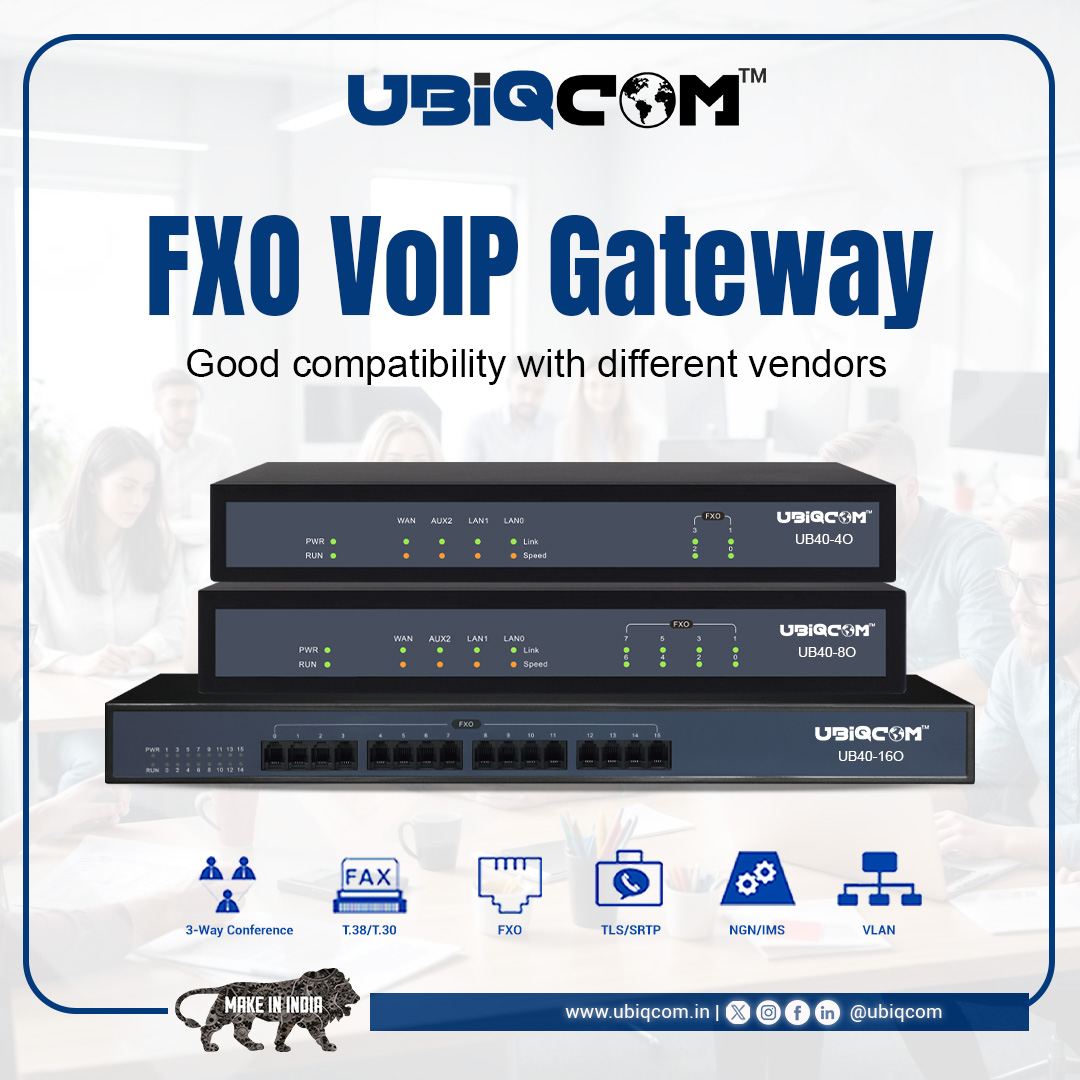What is an FXO VoIP Gateway and Why Your Business Needs One

Strong 8k brings an ultra-HD IPTV experience to your living room and your pocket.
In today’s digital-first business environment, seamless communication is essential. Many companies still rely on traditional phone lines for critical operations, while also moving toward VoIP (Voice over IP) to take advantage of internet-based calling. An FXO VoIP Gateway bridges the gap between traditional telephony (PSTN) and modern IP-based systems, offering a cost-effective and scalable communication solution.
If you're seeking a way to integrate legacy phone systems with new VoIP infrastructures, an FXO Gateway could be the perfect fit. In this article, we’ll explore what FXO VoIP Gateways are, how they work, and why choosing solutions like the UBIQCOM FXO Gateway can streamline your business communication system.
What is an FXO VoIP Gateway?
An FXO VoIP Gateway is a network device that connects analog phone lines from the Public Switched Telephone Network (PSTN) to a Voice over IP network. FXO stands for Foreign Exchange Office, and in this context, an FXO port is designed to connect to the central office line of the telephone provider.
In simpler terms, an FXO Gateway allows a VoIP phone system to make and receive calls over traditional analog phone lines. This is especially useful for businesses that are transitioning to VoIP but still rely on PSTN for incoming or outgoing calls.
How Does an FXO Gateway Work?
The FXO Gateway acts as a bridge between your VoIP system and the traditional phone network. It translates analog signals from PSTN lines into digital packets that your IP phone system can understand, and vice versa.
Here’s a basic workflow:
- Incoming Call: A call comes in from a PSTN line.
- FXO Port Receives the Call: The FXO Gateway receives this call through its FXO port.
- Signal Conversion: The analog signal is converted into a digital VoIP signal.
- Routing to IP Network: The call is then routed to the IP PBX or VoIP phones.
Likewise, for outgoing calls from VoIP phones to analog lines, the FXO Gateway converts the digital signals back to analog for transmission through the PSTN.
Benefits of Using an FXO VoIP Gateway
1. Cost-Effective PSTN Integration
Instead of abandoning your existing PSTN infrastructure, an FXO Gateway enables your business to use both VoIP and traditional lines. This helps reduce costs associated with complete overhauls.
2. Improved Redundancy and Reliability
One of the main reasons businesses still maintain analog lines is for redundancy. In case of an internet outage or VoIP server failure, PSTN lines connected via an FXO VoIP Gateway can serve as a backup, ensuring your business stays connected.
3. Scalability
As your business grows, you can easily scale your telephony infrastructure. With devices like the UBIQCOM FXO Gateway, adding more PSTN lines to your VoIP system is as simple as plugging in more FXO ports.
4. Better Call Quality in Some Cases
While VoIP is generally known for high-quality calls, local PSTN lines can sometimes offer better clarity in areas with limited internet bandwidth. Using an FXO Gateway ensures you can route calls intelligently depending on the quality and cost.
5. Supports Legacy Devices
Many businesses still use analog phones, fax machines, or security systems that require traditional phone lines. An FXO VoIP Gateway allows you to integrate these legacy devices into your VoIP ecosystem.
Use Cases of FXO VoIP Gateways
Small to Medium Enterprises (SMEs): Use FXO Gateways to slowly transition from analog to IP systems.
- Hotels and Hospitality: Integrate analog room phones with centralized VoIP systems.
- Call Centers: Use multiple PSTN lines for inbound and outbound calls.
- Remote Offices: Maintain local phone lines with VoIP connectivity to head office.
Why Choose the UBIQCOM FXO Gateway?
When selecting an FXO Gateway, reliability, compatibility, and support are key. The UBIQCOM FXO Gateway stands out as a top choice for businesses looking for robust analog-to-IP integration.
Key Features of UBIQCOM FXO Gateway:
- High-Performance Hardware: Designed for stability and long-term use, even in high-traffic environments.
- Easy Configuration: UBIQCOM provides intuitive web interfaces and full support for SIP protocol, making setup a breeze.
- Wide Compatibility: Works seamlessly with IP PBX systems, including Asterisk, 3CX, FreePBX, and more.
- Advanced Routing Capabilities: Supports least-cost routing, failover routes, and custom dial plans.
Remote Management: Built-in tools for remote configuration and monitoring, perfect for distributed teams.
Whether you run a small office or a multi-location enterprise, UBIQCOM FXO Gateways offer flexibility and performance you can count on.
FXO VoIP Gateway vs. FXS Gateway: What’s the Difference?
Many users get confused between FXO and FXS gateways. Here's a quick comparison:
Feature FXO Gateway FXS Gateway
- Connects to PSTN (Phone lines) Analog phones or fax machines
- Used for Receiving analog lines Providing dial tone to analog devices
- Converts Analog line to VoIP VoIP to analog signal for legacy phones
If you're integrating analog lines into your VoIP network, you need an FXO VoIP Gateway. If you're trying to connect analog phones to a VoIP system, you need an FXS Gateway.
How to Set Up an FXO Gateway
Setting up an FXO Gateway like the UBIQCOM model generally follows these steps:
- Connect PSTN lines to the FXO ports on the gateway.
- Connect the gateway to your LAN using an Ethernet cable.
- Configure SIP settings via the web interface, including IP PBX credentials.
- Define call routing rules to manage incoming and outgoing calls.
- Test calls to ensure everything works seamlessly.
Always consult the device’s user manual or reach out to technical support for specific setup details.
Final Thoughts
An FXO VoIP Gateway is an essential tool for businesses looking to bridge the gap between analog telephony and IP-based systems. It enables seamless communication, improved redundancy, and significant cost savings—all while leveraging your existing phone lines.
If you're searching for a reliable, scalable solution, the UBIQCOM FXO Gateway offers all the features needed to future-proof your communications infrastructure.
Note: IndiBlogHub features both user-submitted and editorial content. We do not verify third-party contributions. Read our Disclaimer and Privacy Policyfor details.







